yesterday's tennessee

Henderson County Times Community Series
This article appeared in the Henderson County Times circa 1982. This web page was made from clippings in a scrapbook labeled "Henderson County Historical Society 1982-1983" compiled by Virginia Butler, President 1982-1983.
The history of Reagan, Tennessee began back in the early 1800's. Now when you think of Reagan it covers a large territory because the community has a postoffice and it encompasses a large area. In the middle of this area was the heartbeat of Reagan.
Some of the first settlers here were Powers, Thompson, Bailey, Stewart, Freeman, Smith, Martin, Middleton, Pierce, Wilkinson, Taylor, Stanfill, Wallace, Segerson, Hodgin, Beacham, Sheppard, Benson, and Woods. Of course some of these came here before others.
The first thing the settlers did when they located was to build their homes and then they would build a church and school. The first church was a log building located at the foot of a hill close to a spring. There was large tall grass that grew all around this spring except for the path that led to it. It was so clean that shorter grass would not grow. This path was the one the large wild animals used going to the spring to get water so that is how the church got its name, Barren Springs Primitive Baptist Church.
The benches in the church were simply split logs. The next church was located in the front part of the cemetery where the magnolia trees are. Those trees were planted by John Benson.
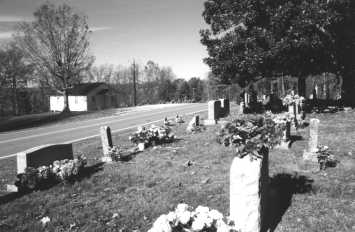
1998 View of Barren Springs Church, Cemetery,
and Magnolia Tree
The next building was located where it is today. The minutes of Barren Springs church show that it was started in 1825. Some of the first members were John and Mary Jane Sheppard, J. O. and Lucinda (Woods) Smith, Wiley and Mary (Sheppard) Benson, John and Sarah Woods.
Mrs. Minnie Bailey can remember going to the church across the road. Her daughter. Estelle Helms and Howard Martin told us the history of the church. Mrs. Helms has a genealogy of all the first members. Lavin Benson was one of the first buried there and his father was a soldier in the Revolutionary War.
The settlers had to grow their food so there had to be mills to make some of the food edible or mills to saw the lumber. So there were grist mills, sawmills, a store to buy things that were really needed, gin, blacksmith shop. Some of the first businessmen were J. D. Scott and Co., R. R. Taylor, G. W. Hodgin and Co. and later there were others.
John H. Hodgin gave the land for the Mt. Moriah Church and cemetery. The first church was a log building located in the cemetery. It was replaced with a large weatherboard building. Finally a new block building was erected across the road from the cemetery. Fourth Sunday in May is the homecoming day at the cemetery. This once was a big, big day for scores of people would come everywhere so many that you would have to park a half mile down either side of the road.
But times changes things and people, and although enough people still come to have dinner on the ground and talk about the past there are not as many as there once was.
Since we are still on the subject of churches we'll write here about the Presbyterian Church that was built later. A William Thorne from McKenzie was one of the pastors. He would ride on a train to Warrens Bluff and if the men were too busy to meet he would walk through Shady Hill and on to Reagan. He came once a month on a Saturday to visit people and then would preach on Sunday. If everyone was too busy to take him around to visit, Mr. Rice Stanfill would hitch his horse to the buggy and have his son, Buford, who was just a kid at the time, to drive Bro. Thorne where he wanted to go.
This church was supported by the Southwestern College of Memphis and the area Presbyterian Churches that were financially able to help would send help at Christmas. Some of the men would meet the train in a wagon to get the toys, clothes and shoes and boots and bring them back for the ladies to see that every child got something for Christmas. They looked forward to this.
After the membership got low, the minister and records were moved to the Marl Bluff Church. The building was sold to Mr. and Mrs. Everett Wallace. They converted it into a house and they still live in it today.
We don't know when Ridley's Chapel was established but the cemetery there has tombstones dating back to 1848. That could have been the beginning.
It was a Presbyterian Church at first. Bro. Thorne preached there some.
Dyer's Chapel Church of Christ was started in the mid 1930's when several of Dyer families moved here from Sardis. It was too far and hard to get back to us for church so they began having services or Bible classes in homes and in the summer they had a brush-harbor to hold services. Finally the members did the work and they built their first church, a frame building. Later they build the present brick building. A few years ago, they started a cemetery there and have homecoming the Fourth Sunday in May.
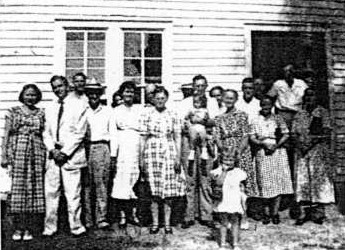
The first church at Dyer's Chapel. This was taken at a revival.
Going back to the beginning, we know that some of the early settlers were Daniel S. and Vina (Sheppard) Beacham. Their son, G. W. Beacham was born in ___ [year cut off] here. Goodspeed's History book states that G. W. Beacham was very successful as a farmer. He owned about 500 acres of valuable land. His signature is on the original deed to Barren Spring Church. G. W.'s homeplace was located at the end of the road that is in front of Angie Mae Dyer's house. G. W.'s daughter, Vina Beacham, lived her entire life at this homeplace. She was 96 years old when she died.
The Smith's settled toward Shady Hill near Reagan. Dee Smith and son, Joe and family, still live on the same land their father and grandfather lived on.
The Segersons also lived on the same road only closer to Reagan. They contributed a good deal to the development of this community.
Edd and Ernie Segersorr both worked for Mr. Powers at the store. Irene ___iam still lives at Edd's home place. She is the daughter of Ermie and Tom Segerson lived closer to Reagan.
The Jake Taylor family lived on the road past Harvey Middleton's.
H. H. Middleton settled around Reagan. Most everyone can remember his sons because of the things they made. John had a blacksmith shop which at one time was at the foot of Barren Springs hill. He had a large family and most of them were very talented with musical instruments and singing. John's widow still lives at his homeplace.
Mr. Jap Middleton was talented in making chairs and could weave any kind of basket you wanted. Probably most still own either a straight chair or rocker or basket he made. His son, Henry, still lives at Reagan. His other son, Wylie, passed away a few weeks ago but he had told us he could remember when peoples wells went dry and everyone had to go to the Barren Springs to get water.
We'll write about other families as we tell more history.
The first school was a one room building located down the road in front of ___ard Grissoms. It had wooden shutters for windows. The blackboard was board painted black and the benches were split logs. The students did their assignments on slates with slate pencils. The school year was two months in the summer and one month in winter. In addition to this, there would be subscription schools where parents were charged a fee of 75 cents each session. This was to pay for the teachers salary.
This information about the first school was taken from a history that the late Miss Paralee Grissom and Mrs. Molly Sega told when they were interviewed by the of the students a few years ago. They both went to school there.
The next school house was built on the hill next to "Pug" Stanfills. Several people that went to school there can remember that one. Some of the teachers were Billy Pierce, Lucy Page, George Curlee, Jim Duck, Jim Austin, Henry ___som [Grissom?], Tom Stanfill and others probably. The teachers usually boarded in the homes of the students for about $5.00 per month.
The schoolhouse was later build at the site where it is today. Also at one time there was a high school too. The high school lasted just a few years and then the students had to go to Sardis, Scotts Hill or Lexington.
Another school that was probably in existence very early was the Thompson schoolhouse. It was located close to where Louise Martin lives. Mr. Arch Martin taught at the school. When the school was done away with there, he tore the schoolhouse down and built his house out of the lumber. This schoolhouse was built on the land where all the Thompson's settled. It reached from Highway 100 past Highway 22. Lots of farms have been sold off the land the Thompson's farmed. It was told that the first Thompson man here rode a horse from North Carolina, took a branch from a fruit tree and planted it where he wanted his house built. There is also a Thompson cemetery close to the Martin's barn. Some of the graves have a fence around them. There are a few tombrocks and several markers of sandrocks. One of the graves is that of a Civil War Veteran. Rob Thompson. Roy Martin puts a flag on his grave each year.
Going back to the Arch Martin house, it was always called the old Thompson house and it is still there although it has been remodeled. It used to have the old phone switchboard. People would call there, they would connect them with Mrs. Hays at Shady Hill and she connected them to Lexington.
The history of Reagan School would not be complete without mentioning Mr. ___n [John?] Bailey and his wife, Jewel. They taught school there many years. Mr. T. V. ___r said all 6 of his children graduated from the 8th grade under his principalship, also two of his grandchildren. So he had a great many children that touched his life.
Tom Bailey's sister. Mrs. Molly Martin cooked at Reagan for several years and Tom's niece, Miss Louise Martin, is a teacher there and has been teaching for several years. She takes great pride in Reagan School.
As we mentioned in the beginning, the community was first named Barren Springs, but in 1881 a congressman John M. Taylor from Lexington named it Reagan in honor of Senator Reagan from Texas.
The postoffice was established in 1884 with the help of Congressman Taylor. So from probably 1820 or 1825 until 1881 Barren Springs community became a populated village. Sixty years of a new beginning of pioneers to a new country, came through the Civil War and became a prosperous beginning of a business community.
Some of the postmasters have been Adam Powers, Alford Stewart, Bob Stewart, Dorsey Bailey and J. D. White. There have been several mail carriers, Washington Freeman, Albert Grissom, Genie Wood, Jack Roby, W. M. Wilkinson, Bob Stewart, Clint Pierce, Neal Hodgin, Orval Milliner and Dorsey Bailey. The post office was moved to Reagan crossing in 1957 and today, J. D. White is the carrier and his daughter, Dianne Ivey is postmistress.
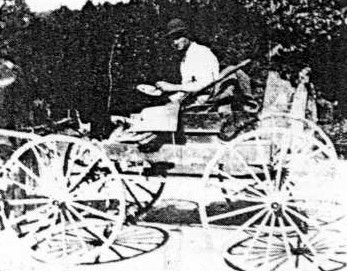
In the late 1800's A.M. Powers built a large store. It was located across the road in front of Willard Grissom's new line. He sold almost everything, groceries on one side of the store and clothing, furniture and hardware on the other side. He sold coffins too and kept them upstairs. Mr. Powers lived across the road from the store and had a large family so he built a big two story southern style house.
Mr. John Wylie Wright also worked for Mr. Powers for 12 years, and his son, Worth Wright was named after one of Mr. Power's sons.
At the time Mr. Powers had a store, Mr. John Stanfill had a blacksmith shop close to the store and Mr. Rice Stanfill had a store by the blacksmith shop. The gin and mills were located on the other side of the store toward the spring, and also behind the store. So this was a "town" at one time.
A Mr. Hodgin had a gin that was run by a big wheel lying at an angle and had to use 3 horses to walk the wheel to make it turn. It was called treadmill. The horses had to keep walking all the time and when one gave out, they put another in and let them rest.
Some of the other businesses at one time were Bud Martin and Raymond Taylor who had sawmill and gristmill, Tom Segerson a gin, Arthur Petty and Robert Wright a gin, grist mill run by John Daniels and later by Ezra Wilkinson, a grist mill by Tom Jowers.
Frank Taylor built the store where Bill Stewart lives and ran a store there first, then later Bud Martin, Wylie Buck, Robert Wilkinson and finally Alford Stewart and then Bill Stewart ran this store. Nellene said when they had that store that it was the hangout place for all the young people at night.
Mary Goff said every Saturday people would come from miles away to buy supplies, get their mules shod, corn ground into meal or flour, bringing baskets of eggs to pay for something they needed. The Wilkinson house was located between Powers Store and where Bill Stewart lives and it had a porch and a big hallway so the women always came there and sat and talked until their husband were ready to go back home. Mary was just a child but she said it sure was a memorable time. Her dad was one of the mail carriers.
He carried the mail by horse and buggy. In the winter when it was so cold Mr. Wilkinson would place a lantern next to his feet to help keep him warm but by the time he would get home in the later afternoon he would be almost frozen. His son, Robert Wilkinson lived there in Reagan and drove a school bus to Reagan and Scotts Hill for 25 years.
Mr. Dorsey Bailey was appointed postmaster in 1933. His salary was $30.00 per month. The postoffice was still at the place beside where "Pug" lives so he borrowed $50.00 from his dad and put in a grocery store too. Later he bought out Mr, Powers and moved to his house and moved the postoffice to the rear of the big store, He later bought a portable sawmill, one that could be moved from one tract of timber to another. He began carrying the mail and later moved to Lexington. He and his son, Eward, formed a partnership in what is still in business in Lexington today, Bailey's Sawmill. He kept carrying the mail route until he retired.
There have been two tragedies that took the lives of some of the citizens of Reagan, Tenn. In 1936, several young people were enroute to Scotts Hill to a rodeo when their bus collided with a Scotts Hill bus and four children from Reagan lost their lives. Those who died were Charles Stewart, Bill and Bessie Stanfill and Buddy Oliver.
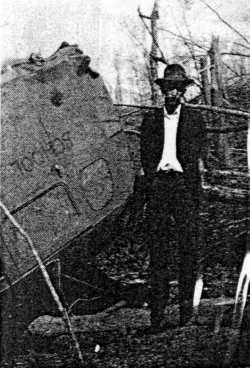
Mr. George Martin barely escaped in the
tornado of 1941 He left his bus and got in
the storm cellar just as it hit. He had
just let the last student off.
Then in 1941 a tornado hit and destroyed the homes of Clint Pierce, Curtis McMurray, and the G. W. Beacham home where his daughter, Vina and his son Harrison and Ruby lived. Mr. and Mrs. McMurry and their two sons lost _______ {lines missing].
Another man in the community every remembers is Preacher Jowers. He was a Baptist preacher. He and one of his sons had a job to keep the road from Reagan to Lexington in traveling condition. It was just a dirt road and they had to drag the road with a heavy piece of steel behind a steel wheel tractor furnished by the county.
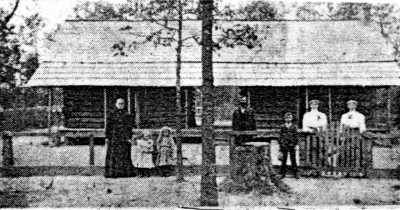
This is the borne of Bob Horton and family located where Clyde Dyer
lives.
Left to right: Emmie, Hattie, Mattie, Bob, Vesta, Ethyl and Mealie.
Picture furnished by Bertha Brantley Johnson. She is
Bob's oldest living granddaughter.
Another family that lived close by on Hwy. 104 past Dyer's Chapel was the Bob Horton family. Mr. and Mrs. Clyde Dyer bought the place and weatherboarded over the logs and closed in the hallway and a few years ago built a new home and Vernie Moody got the old house and moved it down the road where it is today.
The house that "Pug" Stanfill lives in is about the oldest house in Reagan. Buford Stanfill said it was built for a doctor. Lots of different families have lived there. "Pug's" father, John Stanfill, lived there and had a blacksmith shop close by.
The fire tower was built in the early 1950's. The men employed had to climb the steps and look for a sign of smoke to help control forest fires. Buford Stanfill worked there several years and Jim Ervin also was a helper. He lived close to the tower. He also had a grist mill.
Wylie and Missie Middleton once lived in the house that was where Tony Keen's trailer is now.
Bateman Wallace family moved from Union Hill to Bertie Pierce house after Rice Stanfill's family lived there. Then the Wallace family moved to the house that Wylie Middleton lived in. Wylie and Missie moved to Center Hill. Bobby Stewart bought the Bertie Pierce house and his family still own the place although the house burned last year.
Jake Wallace's parents lived there where Tom Bailey later lived close to where the Reagan School is built. Jake still lives close to the Reagan crossing.
Most all the old homes have either been torn down or they burned except where "Pug" Stanfill lives. Bill Stewart still lives in part of the old store built there. Ernie Segerson's house is still standing but empty.
Some of the descendants of the settlers are still living at the old Reagan. Cline Pierce's daughter still lives where her parents lived but it is not the first house there. She is Angie Mae Dyer and she is known by everyone around Reagan because she has been a substitute mail carrier for years. Her grandparents also lived where Claudy Jones house is now. Later Mr. Tom Wallace bought that place and lived there until his death. The original house burned and another was built back. Mr. Wallace's daughter is Gertrude Jones.
The old house built for Molly Stanfill is still there but stands empty now.
Bud Martin's daughter. Mrs. Ethel Stanfill Thompson still lives close by and all her daughters.
Howard Martin's, farm where he lives was once an Indian place for he has found lots of relics and still finds them. He is still an active member of Barren Springs Church. He told us a lot about the church and is an interesting person to talk to.
Today the old Reagan doesn't have any businesses and if you pass by you would never know there had ever been a thriving town.
In 1957, the post office was moved to a building now owned by J. D. White at Reagan Crossing. This is where the Reagan of today now is located. So we'll call it New Reagan.
The new Reagan already had businesses when the post office was moved. Herman Taylor had a store where J. D. White now lives. Wylie Buck had a grocery store where the cafe is today and Fred Buck had a shop close to the store. Later Wylie built a store across the road where Northcutts now owns. Mr. Taylor had moved his sawmill from old Reagan to where the church is today. Mr. Dill had a sawmill and there was a gas station and garage built close to the cafe. Mr. Boyd Austin built and ran a grocery store on the other corner.
Today there are two sawmills, two grocery stores, a parts store, cafe, headstart school, beauty shop and postoffice.
There are many memories of the past to those whose lived began in Barren Springs, Reagan Community. Some are sad and some are good but out of this community came young men and women who went forward to help make better places to live wherever they settled.
Note: The published article included many more photographs than have been scanned for this web page. However, I am working with a xerox copy and cannot get a good image, particularly on the many photographs of people. The following are the captions of photographs not reproduced.--David Donahue, January 1999.
Picture of the late Clint A. Pierce, rural carrier out of Reagan from 1920 to 1948. The melon was given him by a patron M. J. Thompson. The picture was made in 1924 during horse and buggy days. Picture furnished by his daughter, Angle Mae Dyer.
The 8th grade at Reagan school about 1935. It was at the same location as it is now. Back row-l to r: Reaford Stanfill, Mary Martin, Lonnice Segerson, Lillian Hart, Delta Middleton, Venelee Taylor; front row: Cornelia Stewart, Reba Clenney, Roy Martin, Edna Maness, Willard Stanfill, and teacher Mr. Tom Bailey. Picture furnished by Louise Martin.
Vina Beacham lived to be 96. This was taken at Jim Ervin's house.
The Presbyterian Church. Picture furnished by Mr. Everett Wallace. Mr. and Mrs. Everett Wallace live in the old church house.
Mrs. Sarah [Middleton] Boldan and son. Picture furnished by Mrs. Jodie Boldan.
Mr. Arch Martin, sitting in front of his home that he built of the old Thompson school house lumber. He was a teacher in the old school. He lived on part of the land that the Thompsons first settled. There is an old Thompson Cemetery near the house. Roy, his son, puts a flag on the Civil War Veterans grave in the cemetery every year. Roy brought a pencil home one day that was trimmed on a pencil trimmer. His father scolded him and told him be was wasting the pencil and that he used to use one pencil for a whole school term. Picture furnished by Louise Martin.
"Pug" Stanfill, former Chief of Police in Lexington, is a lifelong resident of Reagan. "Pug" is standing in front of his home which is one of the oldest houses in Reagan.
Mr. and Mr. Jap Middleton and children, Wylie, Henry, Mary, Bessie Henry and Fannie Moody. Picture furnished by Perlie Horton.
This picture was made in front of Adam Power's store. Seated are Mr. Ed Segerson, Mr. Adam Powers and Mr. Ernest Segerson. The Segerson brothers helped in the store. This picture was furnished by Bernice [Stewart] Maness. She wrote us a story how she remembered Reagan as she grew up there. She was always told that Adam Powers was the beginning of Reagan. We are keeping the story she wrote and all the ____. [remainder missing]
John Robertson and Margaret Susan [Bailey] Stewart family. Their children, back row, left to right: Elbert, John, Tina [Freeman], Dora, Nannie [Wright], Bertha [Richardson], front row: Alfred [He was the Stewart teacher in the Union Hill school group], Bobby, Gaspard, the baby is Crickett [Bailey]. She was Mayor Ed Bailey's mother. The Stewarts settled between Mt. Moriah and Union Hill and lived there all their lives. Mr. Stewart was a Union soldier.
PIcture furnished by Norma Jones.
This picture was made at Reagan School in the 1930's. Left to right: Dewayne Segerson, unknown, Robert Wilkinson, Charles Stewart, Claude Smith, Fred Smith, George Martin, unknown, Bill Stanfill, Bingham Buck.
The third and present location of the Reagan school. 1931. Part of the class when Reagan had a high school. Left to right: Ruth Segerson, Pauline Zimmerlee, Vera Sue Bailey, Pearl Zimmerlee, Bernice Maness, Joan McKinnistry, and teacher Alvin Todd. Picture furnished by Bernice Maness.
Reagan School about 1917. This was the next location of the school after the log school. It was a frame building located near "Pug" Stanfill's house. Teacher was Manley Harwell. Left back: Walter Ross, Mrs. Ernest Bailey, Robert Wright, Harrison Richardson, Kye Stanfill, Mrs. John R. Holmes, Mrs. Jap Petty, William Rosa, Ernest Freeman, Mrs Jim Thompson, Andy Smith, Jerome Powers, Willie Smith, Robert Davenport, Robert Grissom, Arch Martin, Joe Stanfill, Bill Hodgin, Jake Wallace, Grady Davenport, Worth Powers, Albert Grissom, Hubert Ross, Ed Taylor, Jess Ross, Jim Hodgin, Kye Martin, Dee Smith, Frank Smith, Jake Smith, Homer Davenport, Claude Martin, Mary Freeman, Nannie Smith, Lena Taylor, Martha E. Smith, Mrs. Joe Holmes, Edna Stewart, Mrs. Charlie McCollum, Mrs. Dexter McCall, Frank Taylor, Sr., Mrs. Charlie McCollum and Mrs. Dee Smith both furnished us this picture to use in our story and they told us a lot of history about Reagan.
top · home · yesterday's · families · schools · links · what's new · memorial · about
This site was created by David Donahue and Brenda Kirk Fiddler.
This site is currently maintained by Jerry L. Butler
Copyright © 2004 - 2010, All rights reserved